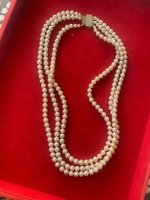mperlas
Member
- Joined
- Oct 8, 2021
- Messages
- 7
Hi everyone!
I've contacted by a client with a request to appreciate a necklace she inherited and which she wants to sell. I have some doubts so I need help. The client assures me that the necklace is from the 1930's. I still need to see them personally but maybe you have some thoughts.
Thank you!
I've contacted by a client with a request to appreciate a necklace she inherited and which she wants to sell. I have some doubts so I need help. The client assures me that the necklace is from the 1930's. I still need to see them personally but maybe you have some thoughts.
Thank you!

